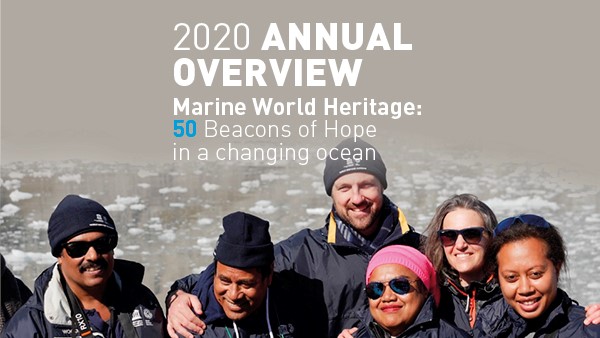
News
Marine World Heritage: 50 Beacons of Hope in a changing ocean

Last year was a year of highs and lows for marine World Heritage. Sites made progress in strengthening climate adaptation capacity, adopting zero emission policies and establishing fisheries no-take zones. The 2020 Annual Overview of the UNESCO World Heritage Marine Programme – which was made public today – summarizes a year of conservation success but also underscores the urgent need for change.
Among the year's highlights are the Belize Barrier Reef Reserve System (Belize) where fisheries no-take zones more than doubled in an effort to build the site's resilience in the face of climate change. The West Norwegian Fjords – Geirangerfjord and Nærøyfjord (Norway) adopted a landmark zero emissions policy and met up with Kluane / Wrangell-St. Elias / Glacier Bay / Tatshenshini-Alsek (USA) to develop more sustainable practices among its visiting cruise ships. Ningaloo Coast (Australia) and the Lagoons of New Caledonia: Reef Diversity and Associated Ecosystems (France) appointed their first Chief Resilience Officer (CRO) as part of the innovative Resilient Reefs Initiative led by an international consortium of partners.
The 4th World Heritage marine managers conference brought together local managers from across the marine World Heritage network and shared their most successful conservation solutions. The conference focused on ways to accelerate achieving the 2030 United Nations Sustainable Development Goals. Topics ranged from establishing private-public collaborations, climate adaptation and resilience strategies, satellite and space technologies, and the growing problem of plastics and marine debris. Site-to-site trainings and conservation assessments were held at Komodo National Park (Indonesia) and Danger-Listed East Rennell (Solomon Islands).
Yet the year's overview also shows the urgent need for change – a need that was once more confirmed with the inscription of the Islands and Protected Areas of the Gulf of California (Mexico) on the List of World Heritage in Danger last June. The decision followed the serious situation in unsustainable and illegal fisheries that contributes to the near extinction of the critically endangered vaquita species.
Today, the UNESCO World Heritage List includes 50 marine sites across 37 countries. The French Austral Lands and Seas (France) – one of the ocean’s last wildernesses, home to over 50 million birds and among the largest marine protected areas on Earth – was added to the List in 2019.
The World Heritage Centre thanks the partners and individuals for their support to the World Heritage Marine Programme in 2019. Protecting our cultural and natural heritage is the responsibility of us all. The Centre is grateful for every contribution made – small and large.



